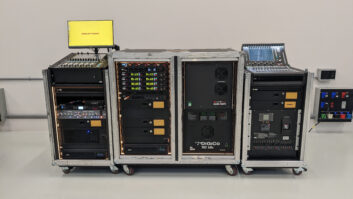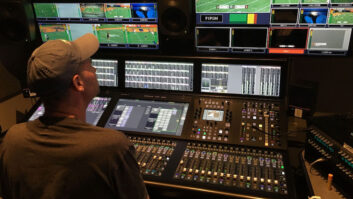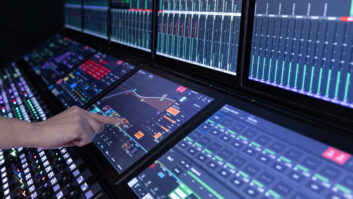Studios tend to hold onto their large-format digital mixing consoles for a while because upgrading a big-ticket item every two years or so can be expensive. But facilities still need to keep pace with technology, whether to improve workflow for mix engineers or to support emergent sound formats—or to simply have tools that are a cut above the competition. How can a studio stay current while still holding onto their boards?
When the Avid S6 came out in 2013, it offered re-recording mixers more comprehensive control over Pro Tools sessions. Keeping mixes in-the-box was already entrenched practice, and the functionality of the S6 improved that workflow. Many mixers jumped on board, including Oscar-winning re-recording mixer Niv Adiri, who was one of the S6’s early adopters. He liked the option of having a different control surface for different aspects of a mix.
“If you’re mixing effects, you might want to use an Avid S6, and if you’re mixing music, you might want to use the AMS Neve DFC,” he says. “That’s what a lot of mixers do these days.”
When a studio didn’t have an S6, Adiri would bring in his own and simply park it on top of the studio’s existing console. It was a temporary fix for what became a permanent staple in his workflow. But stacking the two looked unsightly, and it wasn’t very ergonomic; it also proved hard to get at the console underneath. Like stacking a Lego on top of a Mega Blok, the two mixing surfaces just didn’t fit together.

“If you still want to use the main surface,” Adiri laments, “then you have to put the S6 off to the side, and that means you end up mixing while looking sideways.”
Frozen Fish Design out of London, co-founded by Glenn Haddock and Alan Frost and essentially unknown in the audio world, were approached by Simon Ray and Rob Weatherall at Goldcrest Films to design a solution to integrate the S6 into the DFC in any configuration for their new flagship facility in London. They then engineered a solution, now called the Hybrid Integration System. In very simple terms, HIS combines the Avid S6 with consoles such as the AMS Neve DFC Gemini and the Euphonix System 5, both popular in high-end audio post-production, by placing the smaller S6 components into DFC or System 5–sized buckets.
“The DFC needs our HIS components to make the Avid S6 modules fit,” Haddock explains. “But for the Euphonix System 5, we had to completely remake the buckets. I’d say that is the core of this product, and it’s where our design and manufacture skills have come into play.”
Related: Studio Consoles/Boards/Desks 2018, Aug. 2, 2018
Frozen Fish Design is not an audio company in the traditional sense, though it fits perfectly into the modern recording industry paradigm of digital/analog integration. As Haddock explains, “We come from a much more bespoke world of design for branding, product launches, car shows, and even props for film and TV builds. We design things from scratch, so we’re used to this challenge of ‘I need this to do that,’ or ‘I need to repurpose this to do something it wasn’t originally designed for.’ We saw a deficiency in this area of pro audio that no one was addressing, this issue of having to put one console on top of another in order to work with both consoles.”

The pieces combine into a congruent console that looks as good as it feels. “We’re getting people to understand and appreciate the ergonomics of a console,” he says. “It’s not only about the hardware; it’s how easy and comfortable it is to work on. The ergonomics aren’t a last thought anymore.”
Adiri adds, “Frozen Fish Design helped us to look forward, literally, to look at the screen directly in front of us by giving us the flexibility to move our preferred surface in front of us. They gave us the option to use different surfaces, different controls, on one console desk.”
The company’s first hybrid console, installed at Goldcrest Films, was a hit and was soon followed by Abbey Road and Lipsync Post in London, and RH Factor, Skywalker Sound and 20th Century Fox Studios in the U.S. Adiri has mixed on Frozen Fish Design’s hybrid consoles at several studios, including Pinewood Studios, where he mixed the films Annihilation and Adrift, and at Halo Post in London for the film Paddington.
“Halo installed the hybrid console specifically for Paddington because we asked for it,” Adiri says. “Glenn [Haddock] did an amazing job of integrating the S6 into the DFC 1 at Halo Post.”
Frozen Fish Design recently installed a hybrid console at Wave Studios in Amsterdam—in one evening.
“Their studio was Euphonix System 5 on Thursday night, and by Friday morning we had integrated a new Avid S6 into the basic chassis of the Euphonix,” Haddock says. “The technicians there were saying, ‘Great, we don’t have to throw this away. We don’t have to try to resell it and lose money on it.’ This is a better way to reuse and repurpose consoles, bringing them right up to date. Studios can upgrade to the new equipment gradually. It can be more of a thought-out process. They can integrate the newer equipment into the older equipment, and that gives the equipment a longer life.”

Frozen Fish Design’s bucket solution offers more than integration. It gives studios the ability to reconfigure their consoles to suit any re-recording mixer’s preferences. The layout can literally be made-to-order. That’s a huge draw for high-end film mixers.
Simon Campbell, head of technical services for Abbey Road Studios’ Mix Stage—a Dolby Atmos Premier, DTS:X and IMAX audio accredited film mixing studio—worked with Haddock on a console made entirely of buckets to house both Avid S6 and AMS Neve DFC Gemini components. According to Haddock, the challenge was making sure the support frame underneath could handle the flexibility of unplugging any or all of the buckets and swapping out more or fewer buckets of S6 and DFC Gemini, all while keeping the look of a complete console.
“Having the desk in a bucket style means we can move it all around to suit our clients’ tastes,” Campbell says. “The mixers will get in touch and tell us what bits of desk they want where, and who is sitting where, and what they’ll want within arm’s reach, whether it’s more S6 or more DFC. Then we slot it around accordingly. That makes it flexible and easily adaptable to personal preference, which hopefully makes the mixers happy before they’ve even turned up.”
The custom design for Abbey Road incorporates sliding picture monitor rails on the back of the console desk. Haddock notes that there was limited space at the back of the console where all of the cabling and slide mechanisms are located, “so we had to do a bit of reworking there to make things fit,” he says. The picture monitor rails will be retrofitted onto other consoles at Abbey Road, including the Neve 88Rs in Studio 1 and Studio 2, and onto the SSL J-Series in Studio 3.
Want more stories like this? Subscribe to our newsletter and get it delivered right to your inbox.
“At Abbey Road, we didn’t stop at HIS,” Haddock adds. “We covered a range of accessories and furniture, all designed and engineered to improve the workflow of the mix environment.” In fact, they’ve designed custom console furniture for studios across the world, including in Prague, Netflix LA and VSI Berlin.
With the hybrid console challenge solved, Frozen Fish Design is setting its sights on another industry issue: how to mix while standing up.
“We are working on a rise-and-fall desk for the Avid S6 because workplace health is very important these days,” Haddock concludes. “In fact, my business partner Alan Frost bought himself a sit/stand office desk for his back health. One of our clients said their mixers would be interested in doing a bit of work standing up as well as sitting in the sweet spot. That design is in the pipeline, and we will be able to launch it shortly.”







